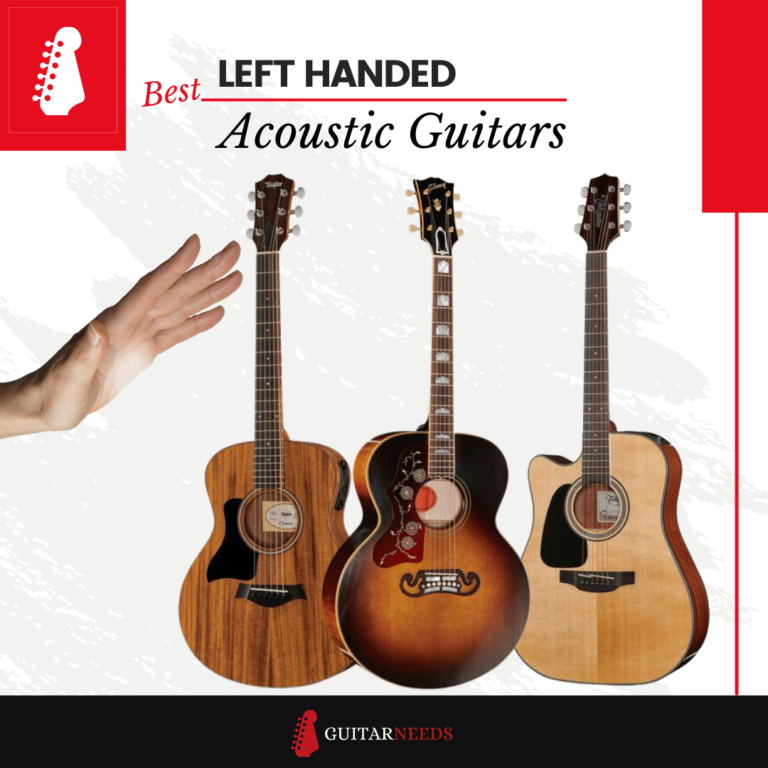This is my list of the best left handed acoustic guitars.
Ever wondered why left-handed guitars exist? Simple. Because not all superheroes play right-handed. 🎸💥
In the world of music, they say left-handers are the universe’s way of adding a plot twist. Imagine this: A guitarist steps onto the stage, the crowd gasps as they notice… the guitar’s all “backwards”! But as the first notes ring out, it’s clear that this isn’t a mistake—it’s magic.
Lefties might be the minority in a right-hand dominant world, but when it comes to making music, they’ve got their unique rhythm (and a special set of strings to match). Whether you’re a proud southpaw or just guitar-curious, come strum along on this special journey into the left-hand lane of acoustic guitars. Buckle up; it’s going to be a melodious ride!
1. Taylor 114ce LH

Best of Left Handed Acoustic Guitars for Fingerpicking
Main Characteristics:
- Shape: Grand Auditorium
- Top Wood: Solid Sitka Spruce
- Back & Sides: Layered Walnut
- Price: ~$900
Check price:
Body and Neck: The grand auditorium shape is Taylor’s pride, offering a versatile playing experience. The solid Sitka spruce top coupled with layered walnut back and sides makes for a visually stunning instrument.
Playability: A smooth satin neck finish and a slightly narrower 1 11/16-inch nut width make fingerpicking on the 114ce a dream.
Electronics and Hardware: Comes with Taylor’s signature ES2 electronics that offer a clear and natural amplified sound.
Sound: The 114ce produces a clear, well-balanced tone with a bright treble response, making it ideal for fingerpickers.
Customer Reviews: “Taylors produces some of the absolute best acoustic guitars available. In particular, the mid-range lines, where the Taylor 114ce makes a living, give you a ton of guitar for the money.” “The clarity in each note is unmatched,” raved one player. Another player says: “Perfect for those fingerstyle blues!”
Pros and Cons:
- Pros: Superior fingerpicking clarity, robust build, top-notch electronics.
- Cons: Might be a bit pricey for some.
Final Verdict: For fingerpicking enthusiasts, the Taylor 114ce stands out as a clear winner with its unparalleled tonal clarity and ease of play.
2. Gibson J-45 Standard VS LH

Best of Left Handed Acoustic Guitars with Vintage Vibes
Main Characteristics:
- Shape: Round Shoulder Dreadnought
- Top Wood: Sitka Spruce
- Back & Sides: Mahogany
- Price: ~$2,500
Check price:
Body and Neck: The J-45 showcases that classic round-shoulder dreadnought shape with a vintage sunburst finish that screams “rock n’ roll history.”
Playability: A smooth-playing rosewood fingerboard combined with a comfortable neck profile ensures that this guitar feels as good as it looks.
Electronics and Hardware: Boasts an LR Baggs VTC pickup system, which is perfect for those wanting a natural sound when plugged in.
Sound: Its tonal warmth, balanced mids, and clear highs make it a beloved choice of many professional musicians.
Customer Reviews:
- “A well-balanced model that can perform just about everything well and are willing to spend top bucks on a premium acoustic.”
- “A trip back in time with every strum”
- “It’s like having a piece of music history”
Pros and Cons:
- Pros: Vintage aesthetics, warm and balanced sound, impeccable build quality.
- Cons: Definitely on the pricier side.
Final Verdict: For those willing to invest, the Gibson J-45 not only offers a trip down memory lane but also promises top-notch sound and playability.
3. Yamaha FG820L NTII
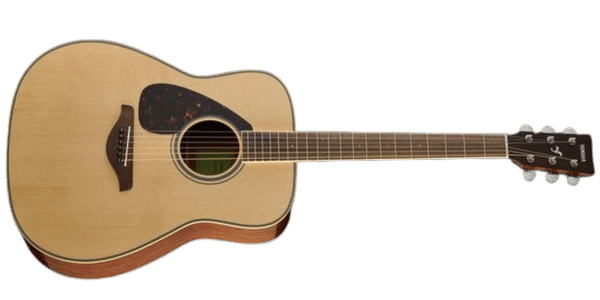
Best of Budget Left Handed Acoustic Guitars
Main Characteristics:
- Shape: Traditional Western Body
- Top Wood: Solid Spruce
- Back & Sides: Mahogany
- Price: ~$300
Check price:
Body and Neck: The traditional western body shape is a testament to Yamaha’s commitment to classic designs. The solid spruce top paired with mahogany back and sides offers a touch of luxury at a budget-friendly price.
Playability: Its smooth rosewood fretboard ensures every note rings out clear, making it a joy to play for both newbies and pros.
Electronics and Hardware: While it lacks built-in electronics, the hardware is sturdy and reliable, fitting for its price range.
Sound: It has a rich mid-range with punchy lows, making it suitable for a variety of music styles.
Customer Reviews:
- This is the best guitar for the money there is period. I am a professional musician and mainly a Martin and other manufacturers collector and seller. I use to use expensive Martins as my stage guitars ( Martin 1996 000-28 12 fret GE and a 1993 OM-28 Perry Bechtel) They both have LR bags Dual Source for amplification. This guitar amplification has been around for over 20 years and in my opinion it is still the best natural sound amplification there is. You set it to stereo and use a Y cable to run it to the mixer so you can put both the mic and the pickup to the crowd and the ribbon bridge pickup to your monitors to eliminate feedback. If you have a DBS Driverack system you dial it in and can put the mic in your monitors too.
- This guitar has a solid Sitka spruce top with scalloped bracing. How cool is that? It also has mini tuners that lighten the headstock and yes, it improves the playability and it improves the sound. Yamaha was thinking and they unlike most companies try to satisfy you and are not out to steal your money. They are out to give you a great deal. **********stars
- “Didn’t expect such quality at this price!” mentioned one happy player. “A steal for beginners,” claimed another.
Pros and Cons:
- Pros: Affordable, versatile sound, great build for the price.
- Cons: Lacks onboard electronics.
Final Verdict: For those on a budget, the Yamaha FG820L offers incredible value without compromising on sound and quality.
4. Seagull S6 Original LEFT

Best of Left Handed Acoustic Guitars for Beginners
Main Characteristics:
- Shape: Dreadnought
- Top Wood: Solid Cedar
- Back & Sides: Wild Cherry
- Price: ~$500
Check price:
Body and Neck: Crafted in Canada, its dreadnought shape combined with unique wood choices gives it both a classic and fresh appearance.
Playability: The slim neck and low action setup make it a beginner’s dream, reducing finger strain and ensuring longer playing sessions.
Electronics and Hardware: Though it lacks electronics, its hardware is reliable, with sealed tuners that maintain tuning stability.
Sound: Warm and vibrant, with the cedar top giving it a distinctive mellow edge perfect for strumming.
Customer Reviews:
- I’ve had this guitar for 7 months. Well made, good finish, plays well. Back and sides are a bit garish, wild cherry with prominent wavy grain. Unplugged tone and volume are OK, a bit weak. Electronics are good. Fingerboard/neck width is wider than a standard acoustic, about 47.5mm vs 44mm at 1st fret. Overall a good value, well-made guitar with electronics.
- “Makes learning a breeze,” one beginner pointed out. Another said, “The cedar top is a game-changer for tone.”
Pros and Cons:
- Pros: Beginner-friendly playability, unique tone, sturdy construction.
- Cons: Absence of built-in electronics.
Final Verdict: The Seagull S6 stands out as a top pick for beginners, ensuring a smooth learning curve without breaking the bank.
5. Takamine GD30CE-LH NAT
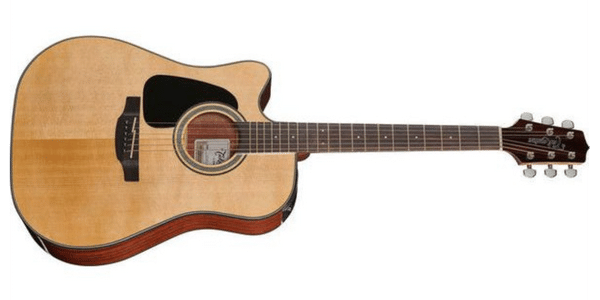
Best of Left Handed Acoustic Guitars for Performing on Stage
Main Characteristics:
- Shape: Dreadnought Cutaway
- Top Wood: Solid Spruce
- Back & Sides: Mahogany
- Price: ~$550
Check price:
Body and Neck: The cutaway design not only looks stylish but provides easy access to higher frets. Classic wood choices ensure it’s not just all looks.
Playability: A sleek neck and cutaway design make it easy to handle, especially for those soloing adventures up the fretboard.
Electronics and Hardware: Packed with Takamine’s TP-4TD preamp system, it promises stage-ready sound with a built-in tuner for convenience.
Sound: Bright and balanced with a punchy projection, suitable for live performances.
Customer Reviews:
- Perfect playability, smooth, low action, great sound. For the price, I don’t think it can be beat. I love the pinless bridge feature on this guitar. I would definitely recommend this guitar to anyone.
- “My go-to for gigs!” one passionate performer noted. “The built-in tuner is a lifesaver,” added another.
Pros and Cons:
- Pros: Stage-ready electronics, sleek cutaway design, balanced sound.
- Cons: Might be slightly bright for some tastes.
Final Verdict: For performers looking for a stage companion, the Takamine GD30CE-LH NAT stands tall with its playability and reliable electronics.
6. Fender CD-60S LH
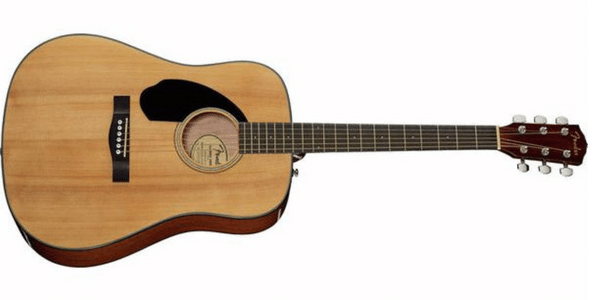
Best of Left Handed Acoustic Guitars with Classic Look
Main Characteristics:
- Shape: Dreadnought
- Top Wood: Solid Mahogany
- Back & Sides: Laminated Mahogany
- Price: ~$230
Check price:
Body and Neck: Embracing a classic dreadnought silhouette, Fender sticks to its roots. The all-mahogany construction lends it a cohesive and ageless appearance.
Playability: With a comfortable neck profile and easily accessible frets, it caters well to both novice and adept players.
Electronics and Hardware: While primarily an acoustic, the hardware is robust. The chrome die-cast tuners ensure you stay in tune.
Sound: Deep and resonant. The mahogany body imparts a warm tonality that’s especially inviting for folk and blues players.
Customer Reviews:
- a good choice for a beginner or a trusty backup for a songwriter. It features a special combination of tonewoods with a spruce top and mahogany back and sides. It then adds nice playability and sound, making the CD-60S a guitar that is better than most beginner guitars at this price point.
- “Looks vintage, sounds timeless,” one enthusiast shared. Another remarked, “An old-school vibe with a modern touch.”
Pros and Cons:
- Pros: Classic aesthetics, rich tonality, affordability.
- Cons: Lacks onboard electronics.
Final Verdict: If you’re seeking that timeless look paired with a warm, encompassing sound, the Fender CD-60S LH doesn’t disappoint.
7. Ibanez AW54LCE-OPN
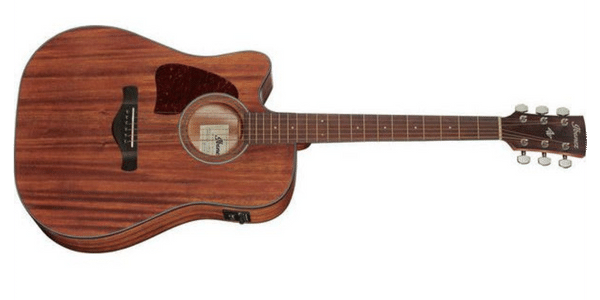
Best of Left Handed Acoustic Guitars for Blues
Main Characteristics:
- Shape: Dreadnought
- Top Wood: Solid Okoume
- Back & Sides: Okoume
- Price: ~$400
Check price:
Body and Neck: This Ibanez model exudes a rustic charm with its open pore finish. The all-okoume construction gives it a distinguished look.
Playability: With a satin-finished neck, players can slide effortlessly across frets, making those blues licks come alive.
Electronics and Hardware: Fitted with Ibanez’s own AEQ-SP2 preamp, it’s stage-ready right out of the box.
Sound: Deep and growling lows paired with expressive mids make it ideal for blues and jazz players.
Customer Reviews:
- I’ve only had the AW54LCEOPN for a few days, but all I can say is wow! This guitar looks, plays and sounds beautiful. I bought it to replace another lefty acoustic electric that I’ve never been happy with and the difference between the two is amazing. The action on this thing is low and the neck is smooth and slim so playing it is remarkably easy. The tone really resonates. It really has a professional sound that I would only have expected from a much more expensive guitar.
- I’ve already taken it to a guitar night with a group of friends and everyone was impressed.
- Setup and shipping was perfect as well!
- It’s got that bluesy soul. The open pore finish feels organic.
Pros and Cons:
- Pros: Bluesy tonality, rustic aesthetics, excellent onboard electronics.
- Cons: Open pore finish might not be for everyone.
Final Verdict: For those who have the blues in their bones, the Ibanez AW54LCEOPN resonates with soulful depth and character.
8. Gibson 1957 SJ-200 VS LH
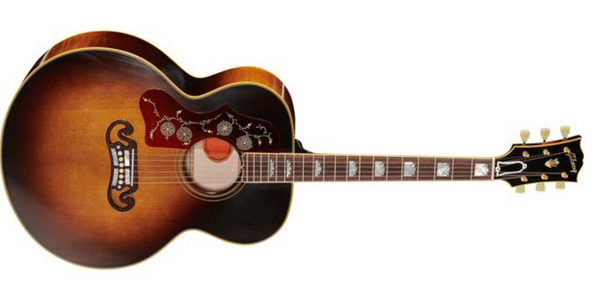
Best of High-End Left Handed Acoustic Guitars
Main Characteristics:
- Shape: Super Jumbo
- Top Wood: Sitka Spruce
- Back & Sides: Maple
- Price: ~$4,000
Check price:
Body and Neck: A pinnacle of guitar craftsmanship. Its impressive super jumbo shape coupled with ornate detailing screams luxury.
Playability: Despite its grandeur, the neck is crafted to provide smooth play, ensuring premium experience.
Electronics and Hardware: Fitted with an LR Baggs pickup system, it’s primed for any setting, from intimate settings to grand stages.
Sound: Big, bold, and beautiful. The J-200 offers a sound as grand as its appearance.
Customer Reviews:
- The Rolls Royce of guitars!, worth every penny.
Pros and Cons:
- Pros: Impeccable craftsmanship, superior sound projection, premium electronics.
- Cons: Pricey for the average consumer.
Final Verdict: If you’re looking to splurge on a guitar that matches its price tag in quality and sound, the Gibson J-200 Standard LH is the top-tier choice.
9. Taylor GS Mini-e LH
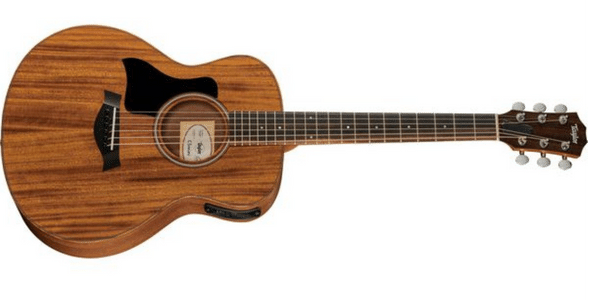
Best of Compact Size Left Handed Acoustic Guitars
Main Characteristics:
- Shape: GS Mini
- Top Wood: Solid Sitka Spruce
- Back & Sides: Layered Rosewood
- Price: ~$650
Check price:
Body and Neck: Despite its petite stature, the GS Mini-e doesn’t skimp on Taylor’s revered craftsmanship. The spruce and rosewood combination is both elegant and resilient.
Playability: Its size makes it a delight to play, especially for younger players or those seeking a more compact option without sacrificing tone.
Electronics and Hardware: With Taylor’s ES-B electronics and built-in tuner, it’s gig-ready anytime, anywhere.
Sound: Expect the unexpected. Its sound defies its size with impressive volume and clarity.
Customer Reviews:
- Small but mighty!
- It’s a Taylor through and through
Pros and Cons:
- Pros: Portable size, robust electronics, premium build quality.
- Cons: Price might be steep for some given its size.
Final Verdict: For those seeking the unmatched quality of a Taylor in a more portable package, the GS Mini-e LH won’t disappoint.
10. Cordoba C5-CE Lefty
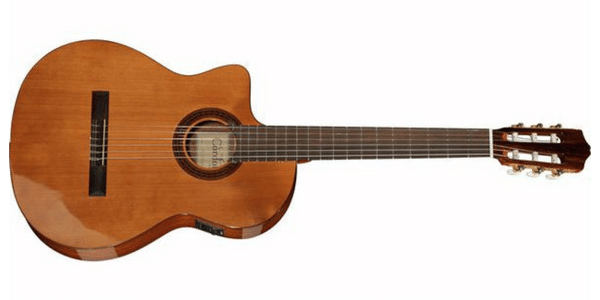
Best of Left Handed Acoustic Guitars with Nylon Strings
Main Characteristics:
- Shape: Classical Cutaway
- Top Wood: Solid Canadian Cedar
- Back & Sides: Mahogany
- Price: ~$450
Check price:
Body and Neck: The Cordoba C5-CE offers lefties a chance to dive into the world of classical guitars with a beautiful cedar top and mahogany back and sides.
Playability: A soft, comfortable neck lets fingers dance with ease, especially crucial for those flamenco rolls and classical arpeggios.
Electronics and Hardware: This model comes with Fishman Isys+ electronics, making it ready for both recitals and bigger venues.
Sound: Warm, deep, and resonant, showcasing the soulful sounds of nylon strings.
Customer Reviews:
- I wanted an affordable nylon string guitar, made with lots of maple. My only complaint was needing to file some of the frets on the low and high e, but, it was a quick tune up. It’s beautiful, it has beautiful tones. The high tension strings I put on make it bright, but, still warm. The electronics are superb. I raised the action, to accommodate my playing style, and it’s still very easy to play. The thin body puts the neck close to you like you’re playing an electric guitar. I would buy some of the more expensive cordobas, but, no need, because this one for $500ish just plays so damn good!
- Perfect for my classical pursuits
- The nylon sound I was seeking
Pros and Cons:
- Pros: Beautiful classical tones, built-in electronics, comfortable playability.
- Cons: Non-traditionalists might yearn for steel strings.
Final Verdict: If you’re yearning for the soft, melodic hum of nylon strings, the Cordoba C5-CE Lefty is a fantastic companion.
With such an array of left-handed acoustics to choose from, southpaw players are no longer sidelined. Whether you’re pinching pennies or looking to splurge, there’s a six-stringed companion waiting just for you. Happy strumming, lefties!
Frequently Asked Questions on Buying a Left-Handed Acoustic Guitar
- Why are there fewer options for left-handed guitars compared to right-handed ones?
- The guitar market caters primarily to right-handed players because they make up a significant majority of the population. Thus, production tends to focus on the demand, which is predominantly right-handed. However, the options for lefties have been growing, thanks to rising awareness and demand.
- Can’t I just restring a right-handed guitar and play it left-handed?
- While it’s possible to restring a right-handed guitar to play it left-handed, it’s not always optimal. The guitar’s bracing, nut slots, and bridge design cater to a specific string order. Flipping it might compromise the sound and playability.
- Are left-handed guitars more expensive than right-handed ones?
- Not necessarily. However, because left-handed guitars are produced in smaller numbers, there might be fewer budget options available. But, in general, the price difference isn’t significant when comparing similar models.
- Is it harder to learn on a left-handed guitar than on a right-handed one?
- The learning curve for guitar playing is based on individual experience, not hand orientation. Whether you pick up a lefty or righty guitar, the challenges and milestones will be similar. It’s about personal comfort and natural inclination.
- Can I get guitar lessons tailored for left-handed players?
- Absolutely! While most guitar tutorials cater to right-handed players, there’s a growing number of instructors and online resources dedicated to left-handed players. It might take a bit more searching, but they’re out there!
- Is there a difference in sound between left and right-handed guitars?
- The orientation of the guitar doesn’t inherently affect the sound. However, the sound might differ based on construction, materials used, and the quality of the guitar. So, a lefty and righty guitar of the same model and make will sound pretty much identical.
- Do all guitar brands offer left-handed models?
- While not all brands offer left-handed models, many of the major ones do. As demand grows, more manufacturers are recognizing the need to cater to left-handed players.
- Should I force myself to learn on a right-handed guitar?
- You shouldn’t force yourself into an orientation that doesn’t feel natural. Some left-handers prefer playing right-handed guitars and vice versa. The key is comfort and what feels intuitive to you. Go with what feels right!
- Is the maintenance for left-handed guitars any different?
- No, the maintenance for left-handed guitars is the same as for right-handed ones. String changing, cleaning, and other care routines apply equally to both.
- Why do some left-handed famous guitarists play right-handed guitars?
- Some left-handed players learned on right-handed guitars either out of necessity (due to a lack of left-handed models) or personal preference. Guitar playing is a deeply personal journey, and what works for one person might not work for another.

